The Braille Workgroup of European Blind Union created a video about the importance of the braille in every day of blind people.
EBU video – the importance of Braille – can be found on the EBU’s website, under Braille promotion section.
The video in different languages
This video has been translated into several other languages, including the audio track and subtitles.
- English: The importance of Braille (external link),
- Spanish: La importancia del Braille (external link),
- German: Die Bedeutung der Blindenschrift (external link),
- French: L’ importance du Braille (external link),
- Swedish: Betydelsen av punktskrift (external link),
- Dutch: Het belang van braille (external link),
- Portuguese: A importância do Braille (external link),
- Slovak: Význam Braillovho písma (external link).
Description of the devices and techniques used in the video
The video is explaining the importance of braille and showing different techniques, how the braille can be produced. As there are more devices and techniques difficult to explain in such a short time, we are going to explain them in this additional article for anybody interested in them.
Just to refresh our memories from the video:
- The braille cell consists of six dots like this: ⠿ it is a matrix of two columns and three rows of dots;
- The alphabet, numbers, symbols, mathematics, music and other areas of scriptures are coded into the braille cells;
- There are different devices for the braille production and different devices or ways to read it;
- Mechanical writing is mostly done by mechanical typewriter, slate and stylus, or different kinds of labellers;
- In the digital environment, braille can be embossed on an embosser and read on the braille display
- Braille can be used even on the screen of a smartphone,. Just like on-screen keyboard.
- Of course, it is possible to connect USB braille keyboards or braille displays to the smartphone, computer, tablet or other devices and let the braille become a inclusive part of the digital environment.
Slate and stylus
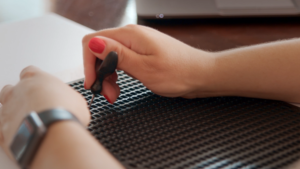
This is the oldest way of writing Braille. Louis Braille Himself was using slate and stylus to punch the dots into the paper while inventing his system of alphabet.
The system of writing the braille with slate and stylus looks a bit tricky. Once it is grasped and trained, it can though be pretty fast. The system is easy. The slate consists of two metal or plastic plates binded together like a book cover. Bottom plate has wholes in the shape and dimensions of braille dots. Upper plate is a grid overlaying the braille cells on the bottom plate. The grid assures the blind person is always sure which dot to punch into the paper, as the grid leads him cell by cell. A paper is inserted between those two plates. After closing the plates, writing can begin. Stylus is rather an ergonomic needle thick enough to not perforate the paper, but punching a dot just in the shape of the wholes in the bottom plate of the slate. This way, dots on the paper arises even and conical. But wait, the dots punched with stylus from above logically appear on the bottom side of the paper. The trick is easy – take the paper out and turn it upside down, or rather bottom side to the front.
Of course, once turning the paper, the dots would turn too and they would not be representing the braille cells we intended. Therefore we have to “turn” the braille cells in our heads as a mirror image before punching the dots. We start to write from right to left and swap the dots positions as follows: first dot has to be punched as fourth, the second dot as the fifth and the third as the sixth dot.
Very nice and explanative video about using the slate and stylus was made by Elizabeth Symington from the UEBÂ Study Group in the Braille Adventures video about using the slate and stylus.
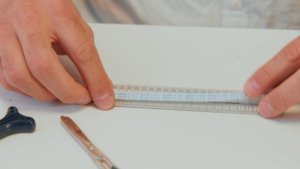
Despite of 200 years of usage, slate and stylus still are the important tool for writing in Braille. There are different sizes of slates and different shapes of styluses, differing in handle ergonomics. There are one-lined, three-lined, 7-lined slates, plastic ones, metal ones, one-sided or even double-sided slates.
DYMO labeller
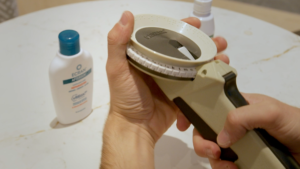
The DYMO is a brand of the adhesive tapes used on standard market for labeling products or places. The tape can hold the embossed relief very well and withstand even inclement weather. But the tape can bear not only a relief latin letters, but also braille. Therefore the devices for labelling in braille were designed for easy use for blind but sighted people as well. Using this labeller is very simple:
- Insert a roll of tape, stretch its beginning in to the nozzle of the device,
- Turn the alphanumeric wheel on the letter/number/sign you want to write (signs are in braille and ink-print latin as well),
- Squeeze the trigger of the device (pins inside will emboss the braille cell and move the tape one cell forward),
- Repeat turning the wheel and squeezing the trigger on the letters you want to emboss,
- On the end turn the wheel to the scissors sign an squeeze the trigger (scissors inside will cut the tape with embossed letters).
- Remove the bottom side of the adhesive tape and stick the label to the desired place.
Tactile pen
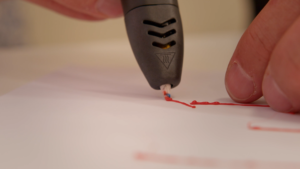
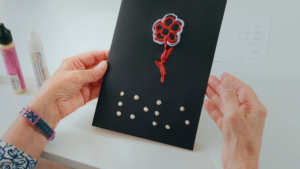
The tactile pen is used for drawing or writing small portions of text or small pictures, mostly for home use, for present cards or for labelling. The pen contains special ink, which usually needs to dry out on the air for several hours. After that though can be touched and the relief can represent picture or braille.
Mechanical braille typewriter
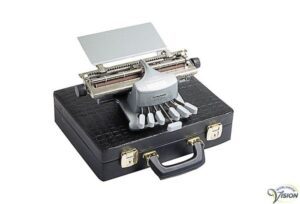
Braille typewriters, also referred to as blind typewriters, substantially increase the speed and quality of writing and reduce the effort required. Unlike the plate and stylus, the braille typewriter embosses positive relief, so there is no need to turn a page to read the written text.
In Europe, the widest commonly used was the mechanical Picht Braille typewriter, which was built by the director of the Berlin Institute for the Blind, Picht. The Picht machine has seven keys. Six keys are for writing dots, the seventh key is for writing spaces between words. The middle key is elongated and its length can be adjusted by dragging it so that the typist can operate it with the palm of his hand. This allows typing with only one hand, while the other hand can be used to read the text being written off or to check the text being typed. The written text can be checked because the dots are punched into the paper from below, and can be read immediately.
With one simultaneous press of a key combination, the typist writes one whole letter. The speed of typing compared to typing on a blackboard is here increased up to four times. Picht’s machine was made for independent writing with the right hand, for independent writing with the left hand, and for writing with both hands.
Tatrapoint braille typewriter, based on the design principle of the Picht machine, is produced in Slovakia. One of its modifications, the Tatrapoint Adaptive model, is designed for two-handed typing only, but the spacing of its keys can be infinitely adjusted and thus adapted to changing hand sizes, which is particularly useful for children. Tatrapoint was initially delivered only on the Slovak market. Exports to foreign markets commenced in 1994. As of today, the typewriters are exported to more than 50 countries around the globe, including Brazil, Indonesia, and the Republic of South Africa.
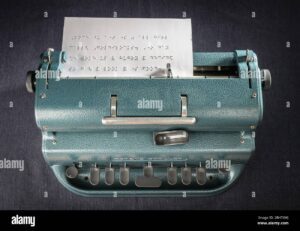
Slightly different approach offers Perkins style braille typewriter. Machines based on the Perkins Brailler design principle are also produced around the world. In this machine, the stamping head moves and the paper cylinder and roll stands still, whereas in a picht machine the stamping mechanism stands still and the paper cylinder and the roll moves. These machines take up less space on the table because their roller does not move sideways, but they are more technically demanding for repair.
Braille embosser
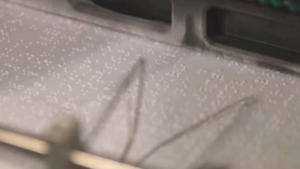
Braille embossers, also known as Braille printers, print Braille text prepared on a computer with the designated software. There are printers with widely varying performance from about 6 characters per second to 400 or more characters per second. The simplest printers print only single-sided, the more sophisticated printers print double-sided and can also print graphics made up of embossing dots. The simplest printers use folded, perforated (tractor) paper, which is both more expensive and more difficult to obtain and requires additional operations after printing (separating individual sheets, trimming margins). The more powerful printers are equipped with feeders for individual sheets of paper, and the most powerful ones take the paper from the roll and automatically cut it to the required page size. Printed paper comes out of the printers stacked in the order the pages are to be bound, i.e. whole copies of each bundle in sequence, rather than copies of one page and then copies of the next page that would need to be carried afterwards.
Braille printers represent a significant advance in the production of books and magazines in Braille, both in volume and timeliness of production. However, they make a revolutionary new contribution to meeting the individual needs of blind people for inclusive education, employment and social participation by enabling large texts to be printed in Braille relatively quickly for individual use.
The braille display

How we could manage without a flexible and reliable device in this digital world? To be able to read braille instantly from the computer’s display, a refreshable braille display was invented.
Depending on the technology used there are more kinds of braille displays in dofferent price levels. Until now, the braille display consisted of one line of braille cells, from 14 to 80 charracters at the same time. The text is refreshing within the line according to the information change on the display or user interactions. A lot more can be found in the article How Do Refreshable Braille Displays Work? : (by Bureau of Internet Accessibility) and list of recent most used Braille displays
Recent years are more and more accenting the need for a multi-lined braile display, which could display information and connections among lines, what is very important in tables, graphs or pictures. The first successful pioneeer in this is Canute 360.
A new dynamic tactile device is being invented by American Printing House – The Monarch.
New braille displays are grasping high interest, as they are expected devices, because reading the display only line by line is cumbersome and spatial dependences on the page are not possible to display. Therefore multi-lined braille displays are the digital braille revolution all the world is welcoming and expecting. The problem with these devices lies in the cost of such a gadget, prices of braille devices are in thousands of euros.
Examples of the well-known braille displays and the newest multi-lined displays:
- Focus Blue Family by Freedom Scientific
- B.note braille displays from Eurobraille
- Alva braille displays from Optelec
- Orbit Reader braille devices from Orbit Research
- other braille displays: Actilino, Active Braille, Braille Star, Braille Wave, Brailliant braille displays, Easy Braille, Seika Braille Displays, Vario braille displays,
- A multi-lined braille display Canute 360 from Bristol Braille Technology
- A multi-lined braille display Orbit Slate from Orbit Research
Braille input keyboard
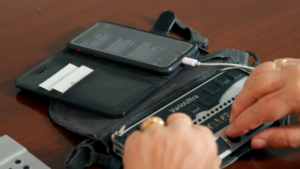
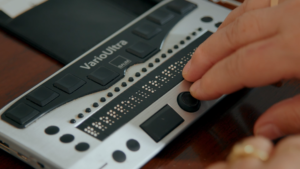
Recently, the IOS or Android smartphones offer a possibility of using an on-screen braille keyboard. How it works? You can see it in this demonstration on Youtube (the video is in Slovak language, but the input keyboard works basically this way in every phone with specific differences).
This buttonless approach is though not comfortable for every blind user. Therefore the braille input keyboards can come very handy. They offer a quick and reliable way to enter the text in braille but appearing in the phone in standard form of latin letters.
A talking teddy bear Braillík
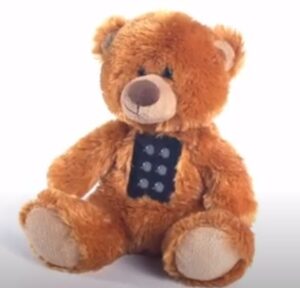
In the video, there appears one small teddy bear. It was called Braillík, as the goal of its inventor was to motivate children to learn braille. The inventor, Martin Dvorecký, gained experience from his very own example as a parent of a blind son. He wanted to give children an opportunity to have a toy, which is pleasant for touch and motivating for learning process. He implemented talking speaker inside the teddy bear and left a plastic pannel protruding from the chest and stomach of the teddy bear. On the pannel, a child can operate six buttons and enter a braille cell, which teddy bears asks for. It can say for example: a doll, d, press dots 145. Once the child presses correct buttons, teddy bear will cheer, or encourage to try one more time, if the combination wasn’t entered correctly.
Website (in Slovak): https://www.braillik.com